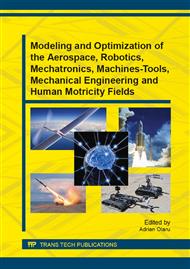[1]
M. H. Raibert, J. J. Craig, Hybrid Position/Force Control of Manipulators, Trans. of the ASME, J. of Dynamic Systems, Measurement and Control, Vol. 102, (1981), 126-133.
DOI: 10.1115/1.3139652
Google Scholar
[2]
S. Arimoto, Mechanics and Control of Robot(in Japanese), Asakura Publishing Co., Ltd., Tokyo, Japan. (1990).
Google Scholar
[3]
T. Yoshikawa, Dynamic Hybrid Position/Force Control of Robot Manipulators— Description of Hand Constraints and Calculation of Joint Driving Force, IEEE J. on Robotics and Automation, Vol. RA-3, No. 5, (1987), 386-392.
DOI: 10.1109/jra.1987.1087120
Google Scholar
[4]
L. Whitcomb, S. Arimoto, T. Naniwa, F. Osaki, Experiments in Adaptive Model-Based Force Control, IEEE Control Systems Society, Vol. 16, No. 1, (1996), 49-57.
Google Scholar
[5]
Z. X. Peng, N. Adachi, Position and Force Control of Manipulators without using Force Sensors (in Japanese), Trans. of JSME(C), Vol. 57, No. 5 37, (1991), 1625-1630.
Google Scholar
[6]
J. Roy, L. L. Whitcomb, Adaptive Force Control of Position/ Velocity Controlled Robots. Theory and Experiment, IEEE Transactions on Robotics and Automation, Vol. 18, No. 2, (2002).
DOI: 10.1109/tra.2002.999642
Google Scholar
[7]
B. Siciliano, L. Villani, Robot Force Control, Kluwer Academic Publishers, U.K. (1999).
Google Scholar
[8]
C. Natale, Interaction Control of Robot Manipulators, Springer Tracts in Advanced Robotics, Germany, (2003).
Google Scholar
[9]
T. Ikeda, M. Minami, Position/Force Control of a Manipulator by using an Algebraic Relation and Evaluations by Experiments. The 2003 IEEE/ASME Int. Conf. on Advanced Intelligent Mechatronics (AIM2003), Proceeding CD-ROM paper No. 159, (2003).
DOI: 10.1109/aim.2003.1225146
Google Scholar
[10]
T. Ikeda, M. Minami, Research of Grinding Robot without Force Sensor by using Algebraic Equation(in Japanese), Transactions of the Japan Society of Mechanical Engineers(C), Vol. 71, No. 7 02, (2005), 270- 277.
DOI: 10.1299/kikaic.71.624
Google Scholar
[11]
M. Minami, W. Xu, Shape-grinding by Direct Position / Force Control with On-line Constraint Estimation, 2008 IEEE/RSJ International Conference on Intelligent Robots and Systems, Acropolis Convention Center, Nice, France, (2008), 943-948.
DOI: 10.1109/iros.2008.4650784
Google Scholar
[12]
Tadeusz Mikolajczyk, Robot Application to Surface Finish Machining, Journal of Polish CIMAC, vol. 5, nr3, (2010), 107-112.
Google Scholar
[13]
Tadeusz Mikolajczyk, Robert Polasik, Non-conventional Milling Using Industrial Robot, Journal of Polish CIMAC, vol. 6, no3, (2011), 159-164.
Google Scholar


